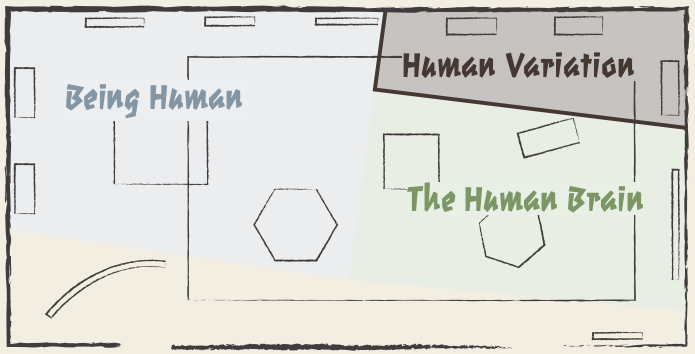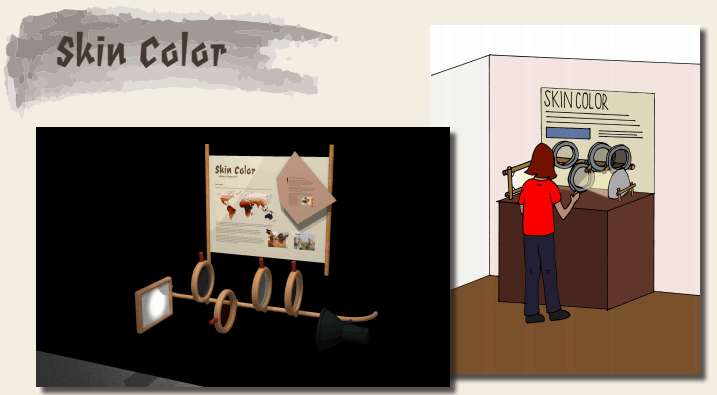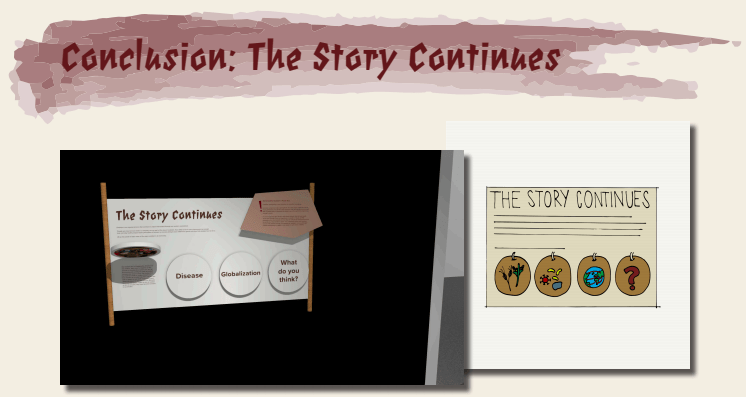Evolved: The Story of Us
Evolved will explore the topic of human evolution and translate it to visitors of all ages and backgrounds. The goal of the exhibition is to provide an informal learning environment in which visitors can experience and think about how human evolution affects their bodies and lives today. It focuses on different features of the human body and offers the visitor interactive activities to explore how they have been shaped over millions of years of evolution. By looking at something that they are extremely familiar with, visitors will see how scientific principles that may seem complex or challenging can be witnessed in action on their own bodies and in their own perceptions and interactions as humans.
The exhibition is organized into three major topics:
- What it means to be human
- How humans vary
- How humans think and communicate.
Each of these major topics is explored through a series of exhibit components that showcase specific topics within them. The components are interactive, allowing visitors to experience first-hand the scientific principles through different activities. Some of the components engage visitors through tactile experiences, while others are visual or auditory in nature. Many of the components can be group experiences that encourage visitors to not only interact with the exhibition, but to engage with one another as they do so. The exhibition is also designed to be a largely non-linear experience. While they work together to teach a common idea and contribute to the larger narrative of the exhibition, the components are independent and can be experienced in any order.
Evolved was designed with a target audience of 11-13 year olds in mind, though it is intended to be accessible to and engaging for visitors of all ages and knowledge levels. The exhibition presents evolutionary concepts in a non-complex and non-intimidating manner, encouraging exploration and providing information in a way that is accessible to those without any background knowledge in evolution.
Introduction
Evolution tells the story of us – from our basic human traits, to why we are all different, to how we think and communicate.
As you move through Evolved, you’ll explore the importance of our different adaptations and see how they came to be as a result of the environmental and cultural changes that occurred throughout human evolutionary history.
Being Human
We are Homo sapiens, or humans. We make up a single species and share 99.9% of our DNA with one another. In this section you’ll explore the defining features of humans that we all share, many of which go back to our earliest evolutionary roots.
Feet
This experience allows participants to compare their foot shape and number of feet with those of other animals. They are able to see how their feet compare to those of other animals who use them in different or similar ways, as well as think about how the way animals use their feet leads to different foot morphologies. By placing the component on the floor, participants are constantly focused on how they are walking and using their own feet.
Visitor Experience
Participants will walk around on a projected surface of different animal footprints. The footprints will represent both quadrupedal and bipedal animals of all sizes to allow for a wide comparison. As participants walk across the surface the will leave a projection of their own human footprint, which they will be able to see and compare with the other footprints around them. These footprints will fade as they walk away, leaving room for other participants.
Bipedalism
Bipedalism is one of the key features of humans, and this module demonstrates the breath and depth of the changes that occurred to make bipedalism possible. A variety of activities allow participants to explore these features through comparisons with our ancestors or other species and interactive challenges. The Foramen Magnum activity allows participants to examine the placement of the foramen magnum as an indicator of bipedalism just as anthropologists do. By comparing at the placement of the spine in quadrupeds and hominin ancestors to its placement in humans they can see how the position of the spine changed in the bipedal transition. The Arthritis activity demonstrates one of the flaws of bipedalism by challenging participants to hold up the amount of weight that the average human pelvis and lower limbs must support 24/7 for several decades. The difficulty of this will show people just how much stress bipedalism places on the lower half of the body and lead them to think about how this pressure results in conditions such as arthritis. The Spine activity, attempting to bend over while standing against the wall, helps to demonstrate what a center of gravity is and why it is so important for balance. This leads into a discussion of how the spine became reoriented during the bipedal transition to place the center of gravity more efficiently. In Childbirth, participants explore another of the flaws of bipedalism, the obstetric dilemma, wherein the pelvis must be as narrow as possible for efficient walking, but wide enough for babies’ heads to pass through. By attempting to pass the babies head through the different pelvises, participants will see how evolution has lead to a compromise between these two necessary traits in the actual human pelvis. The Legs activity demonstrates how our knees have adapted to bipedalism by helping to center our center of gravity. By attempting to walk with a box between their knees, thereby bending their knees outward instead of inward, participants will see how difficult bipedalism is without this trait.
Visitor Experience
This component will consist of six different activities, each exploring a different aspect of bipedal adaptation:
- Foramen Magnum: Participants will place “spine” rods in different “skulls” to see how the positions of the foramen magnum are different in bipeds and quadrupeds.
- Arthritis: Participants will attempt to lift a heavy weight to see how much weight is balanced on their legs and how, over time, this leads to the development of arthritis.
- Spine: Participants will stand against the panel and attempt to bend over and touch their toes to demonstrate the principle of the center of gravity, which has lead to the reshaping of our spines.
- Childbirth: Participants will attempt to pass an infant skull through three different pelvises, each optimized for different demands to demonstrate how the shape of our pelvis is compromise between the demands of childbirth and the demands of walking on two legs.
- Legs: Participants will attempt to walk with a box between their knees to force their knees to bend outward.
Human Variation
It is easy to see that not all humans look the same, so what makes us different? That’s where that 0.01% of DNA we don’t share comes in. In this area you’ll explore how and why we are so diverse.
DNA
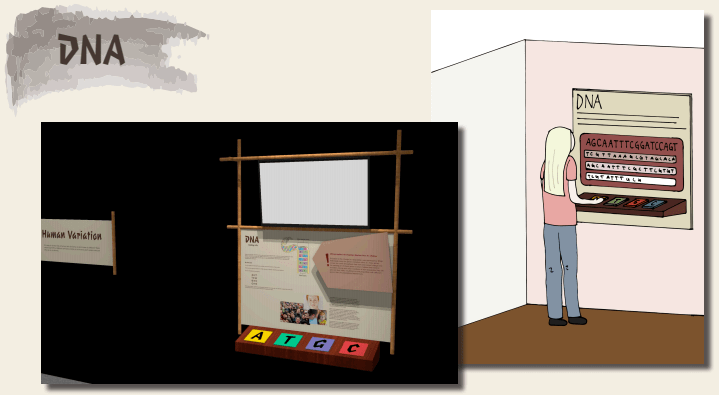
This experience demonstrates not only the importance of DNA as the basic material on which evolution acts to shape our physiological appearance, but also how changes in DNA arise through mutation. As participants translate DNA just as the cell does and naturally make errors of their own, they will see how mutations occur in DNA through mistakes in the translation process. Additionally, this module can act as a transition between the previous thematic grouping and its own by examining the system through which human genes are shared and altered, leading to not just the similarities seen in the previous section, but the differences that will be seen next.
Visitor Experience
Above a digital screen will be a line of DNA code and on the digital screen will be successive lines of that code translated by previous participants. The participant doing the activity will read the bottom line of code and translate it using the base pair buttons. Their translation will appear at the bottom of the screen, and when they have completed it they will compare it with the line of code from which they translated, as well as the original. Any mistakes they made will count as a mutation, and they can see how frequent mutations were not only in their single translation, but also over the time since the original line was translated.
Skin Color
This activity demonstrates how melanin works to block UV rays by blocking light in differing amounts based on the darkness of the lens, a scale that corresponds with the lightness and darkness of skin colors. Visitors will see how darker lenses block out greater amounts of light, just as dark skin does in sunnier climates, and how lighter lenses allow more light to pass through, as light skin does in less sunny climates.
Visitor Experience
Participants will move differently shaded dials in front of a lamp to see the differences in the amount of light that passes through onto a screen. This will demonstrate how melanin pigment in the skin works to block sunlight and show why people with warm-climate ancestry have darker skin than those whose ancestor’s evolved in colder climates with less sunlight.
The Human Brain
If there’s one thing that sets humans apart it’s our large brains. Through this area you’ll explore the abilities our large brains give us, from language to complex technical and creative thought.
Brain Size
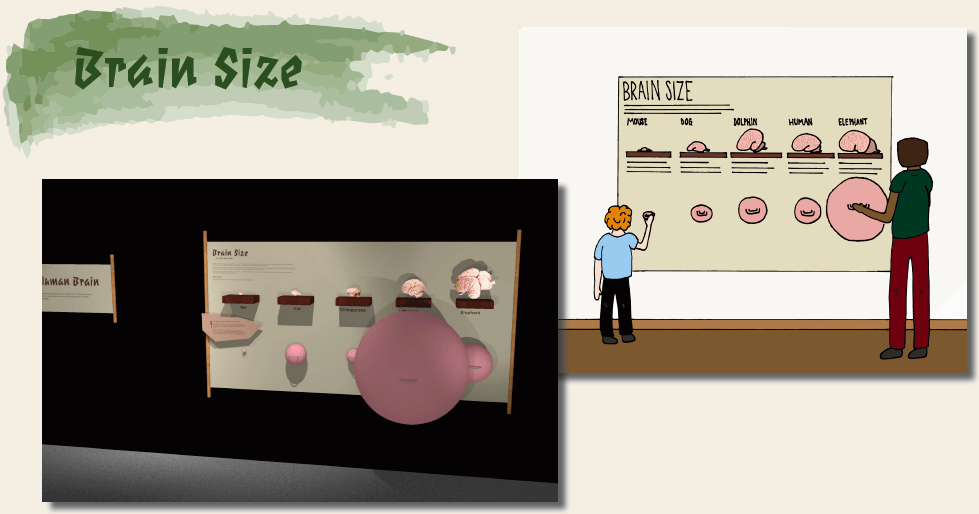 This experience demonstrates how the development of ridges across the surface of the brain allows for greater surface area without an equal increasing in volume. As visitors pull out the spheres they will see how this expansion works. It also shows through comparison with other animals just how large the human brain truly is for its seemingly small size.
This experience demonstrates how the development of ridges across the surface of the brain allows for greater surface area without an equal increasing in volume. As visitors pull out the spheres they will see how this expansion works. It also shows through comparison with other animals just how large the human brain truly is for its seemingly small size.
Visitor Experience
Participants will observe and compare the brain size of a rat, a cat, a chimpanzee, a human, and an elephant through models of their brains. They will then pull on handles of expanding models of the brains of each of the animals to stretch them out to their full surface area. Through this, they will be able to compare them with both their original size and the expansion rates of the other animals’ brains.
Tool Use
This experience demonstrates the importance of tool use to humans by exploring how tools have changed, diversified, and become more complex over time. Through these three activities, participants will see the breadth of tools that have been and are used by humans, illustrating the broad definition of a “tool.” Additionally, they will recognize how tools offer an advantage to the user, demonstrating the evolutionary advantage the ability to use tools has given humans.
Visitor Experience
Through three tasks, participants will see how tools have helped humans to complete ever more complex tasks throughout history. In the first task, participants will attempt to retrieve a higher number of magnetic termites from the termite mound, first with their hand and second with the magnetic “stick” tool. The termites will cling to the magnetic “stick” as real termites do to real sticks, demonstrating how tools make this task of collecting food easier. In the second task, participants will attempt to push a heavy box first by itself, and then with wheels. It will roll easier with the wheels, showing the effectiveness of the wheel as a tool. In the third task, visitors will be given a complex equation and the choice of a chalkboard and chalk or a calculator to do it with. The calculator will make the task much quicker and likely more accurate, showing the importance of computers as tools in the modern world.
The Story Continues
This component wraps up the exhibition by conveying the important message that evolution is an ongoing process and that it is not limited to the features they have just explored in the exhibition. This idea was chosen as a conclusion not only to emphasize how fundamental it is to evolution as a concept, but also to give visitors with something to continue to think about when they leave the exhibition. Presenting visitors with images that represent the factors influencing current human evolution gives them an indication of what they are, and the flaps offer a quick, simple way to get more in depth information on how they work.
Visitor Experience
Participants will lift up different flaps to see how factors in the world today such as food, diseases, globalization, and more continue to shape how the human lineage evolves.






